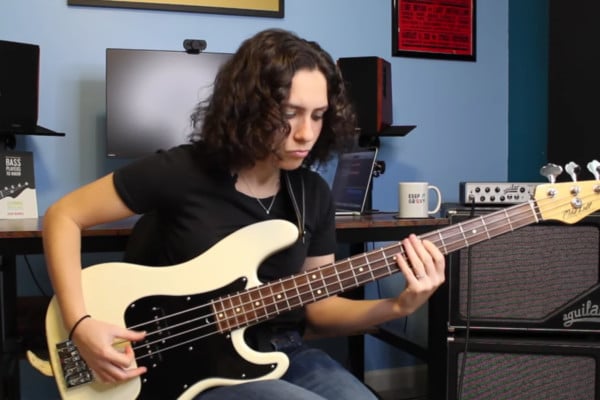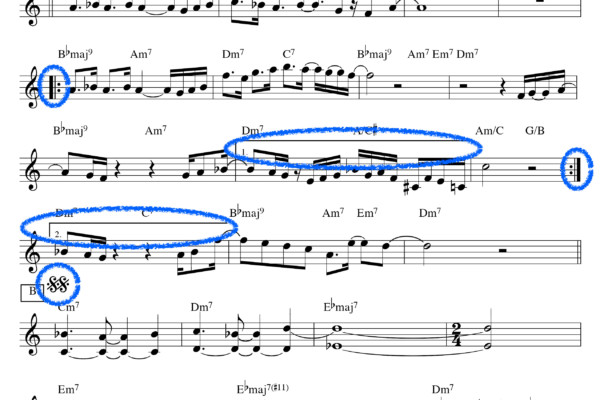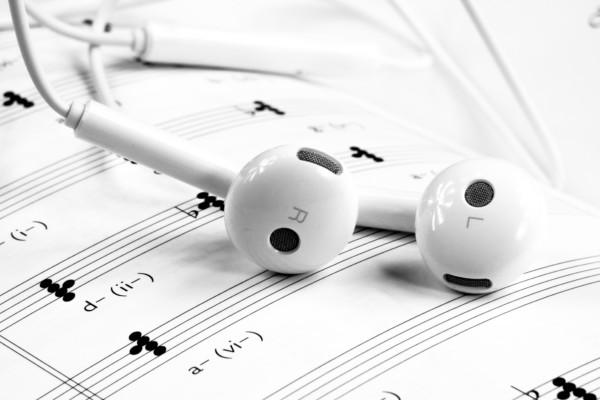Reading a Lead Sheet – A How To Guide
Q: Do you know how to read a lead sheet? What is a good way to learn how to play with a lead sheet?
A: Learning to navigate a lead sheet is one of the most useful and important things a working musician must get comfortable with. While lead sheets seem to baffle many musicians who are unfamiliar with them, they are actually quite simple!
A lead sheet is basically a condensed score of a piece of music with all of the basic information necessary for a band to play that tune.
Within a decent lead sheet you will find:
- The form of the song
- The melody
- The chord changes
Sometimes you may instead receive a “Chord Chart”, which is basically a lead sheet with only the form and chord changes (no melody).
The beautiful thing is, as a bass player, the thing that trips up most of my students is the daunting melody (all of those dots and stems freak folks out), but we don’t need to worry about that! (Although a great musician can read both treble and bass clef and may use that written melody as reference for solos, building bass lines, etc., I occasionally like to read along and catch chunks of the melody within my bass line!)
All the bass player really needs to focus on is the form and the changes.
Changes:
This is the part that can take the most work in order to REALLY get the most out of the written chord changes, but we don’t need to have this mastered before we get rolling with the lead sheet. As we learn more and more about chords, the better we can make good note choices when reading along, but even a rudimentary understanding will get you along in a pinch.
Without going into great detail, this is the crux of it.
When you see a chord symbol, say, G7
The most obvious thing is that “G”. That’s the root of the chord and the note most important to us bass players. When in doubt, you at least know that playing a G will suffice!
Indeed, technically, you could just play along the lead sheet hitting nothing but roots and you would, at the very least, not get in the way harmonically. It might not sound all that happening, but it would work… best to learn the rest of the chord, tho.
Most chords are built in 3rds (in relation to the major scale). Here is a breakdown of chord symbols and what they mean:
- MAJ = 1 3 5 of the major scale (CMAJ = C E G)
- MAJ7 = 1 3 5 7 (can also be written with a ? symbol ie: C?7)
- min = 1 b3 5 (can also be written with a – symbol ie: C-7)
- min7 = 1 b3 5 b7
- 7 = dominant (when you just have the 7 written ie: C7 = 1 3 5 b7
- -7b5 = 1 b3 b5 b7
- SUS4 = play the 4th degree of the scale instead of the 3rd
Then you will also have numbers above 7 occasionally. the easiest way to think about these is to subtract 7 from the number and you get the degree of the scale ie: C-9 = a Cmin chord but with the 2nd degree (or D) placed on top of the chord!
- 9=2
- 11=4
- 13=6
Remember that chords are built in 3rds. This is why the “tensions” or numbers above 7 are written as such a full scale written in 3rds would be:
1 3 5 7 9 11 13
Or, in C Major:
C E G B D F A
It’s a good idea to quiz yourself. Write out the changes to a standard tune on a piece of paper and then try and write in what notes would work for the chords!
Here’s an example:
A-7 | D7 | GMaj7 would be this:
A C E G | D F# A C | G B D F#
Once you understand how chords are built and spelled, reading them becomes 2nd nature. I found it helpful to memorize the SHAPE of the arpeggios. This way, when you see a F-7b5 you can immediately recall the shape of that chord without having to do the math and figure out all of the notes in real time, although eventually you will just know them all after years of doing it.
Form:
The next aspect of the lead sheet is form. basically, you just need to memorize a few symbols and what they mean.
||: :|| = repeat that section
DC = go back to the top of the form
DC al Coda = Go back to the top of the form but take the coda when you see it
Coda = will usually have a bulls-eye at one part of the form with another one near the end. This means that, when it is time to take the coda, you jump from the first bulls-eye to the 2nd. Typically, this is just for the end of a tune but in order to keep a lead sheet down to a page or 2, some charts require you to take the coda every time.
DS al Coda = Jump to the section marked with a DS and then take the coda
This may sound confusing but once you get it, it’s obvious! It’s just not the easiest thing to explain here. I suggest you get a lead sheet and follow along with the music. Once you explore how to properly navigate the chart, the rest becomes much much easier.
I’ve kind of lightly brushed upon all of this stuff, but there is far more detailed information online or in any number of books. If you run into a problem, google your query, search the forums or ask a teacher. It’s really not very hard, you just have to learn the language in order to read it!
Have a question for Damian Erskine? Send it to [email protected]. Check out Damian’s instructional books, Right Hand Drive and The Improviser’s Path.



